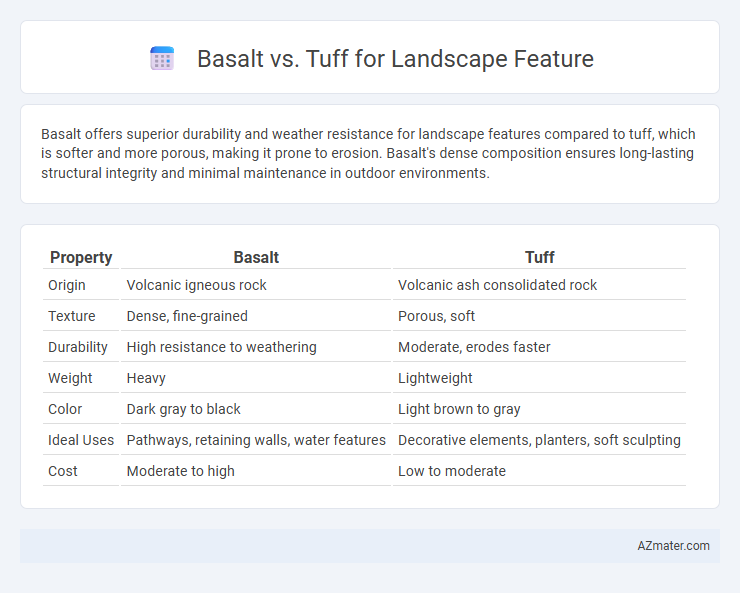Basalt offers superior durability and weather resistance for landscape features compared to tuff, which is softer and more porous, making it prone to erosion. Basalt's dense composition ensures long-lasting structural integrity and minimal maintenance in outdoor environments.
Table of Comparison
| Property | Basalt | Tuff |
|---|---|---|
| Origin | Volcanic igneous rock | Volcanic ash consolidated rock |
| Texture | Dense, fine-grained | Porous, soft |
| Durability | High resistance to weathering | Moderate, erodes faster |
| Weight | Heavy | Lightweight |
| Color | Dark gray to black | Light brown to gray |
| Ideal Uses | Pathways, retaining walls, water features | Decorative elements, planters, soft sculpting |
| Cost | Moderate to high | Low to moderate |
Introduction to Basalt and Tuff
Basalt, a dense volcanic rock formed from rapid cooling of basaltic lava, is prized for its durability and dark, fine-grained texture, making it ideal for resilient landscape features like retaining walls and pathways. Tuff, a lighter volcanic rock composed of consolidated volcanic ash, offers a porous texture and warm earthy colors that enhance naturalistic garden designs and decorative rockeries. Both materials originate from volcanic activity but differ significantly in weight, strength, and aesthetic appeal, influencing their suitability for various landscaping applications.
Geological Origins and Formation
Basalt forms from the rapid cooling of low-viscosity lava rich in iron and magnesium during volcanic eruptions, resulting in a dense, fine-grained igneous rock commonly used in landscape features for durability. Tuff originates from consolidated volcanic ash ejected during explosive eruptions, composed primarily of fragmented volcanic glass and minerals, offering a porous, lightweight texture ideal for decorative landscaping. Both rocks' distinct geological origins influence their aesthetic and physical properties, with basalt providing strength and tuff offering textural variety.
Physical Properties Comparison
Basalt is a dense, fine-grained igneous rock with high durability and resistance to weathering, making it ideal for long-lasting landscape features. Tuff, formed from volcanic ash, is much softer and more porous, which allows easier shaping but reduces its structural strength and longevity outdoors. The physical robustness of basalt contrasts sharply with the lightweight, more friable nature of tuff, influencing their suitability for different landscape applications.
Color and Aesthetic Appeal
Basalt offers a deep, dark gray to black color palette, creating a sleek and modern aesthetic ideal for contrast in landscape designs. Tuff features warmer tones ranging from beige, pink, to rusty red, providing a softer, earthy appeal that blends naturally with garden elements. Both materials add unique textures, but basalt's dense, fine-grained surface contrasts with tuff's porous, rugged appearance, influencing their visual impact in outdoor features.
Durability and Weather Resistance
Basalt offers superior durability and weather resistance compared to tuff due to its dense, fine-grained volcanic composition, which makes it highly resistant to erosion, freeze-thaw cycles, and chemical weathering. Tuff, being a softer, porous volcanic rock, is more susceptible to wear, water absorption, and degradation in harsh weather conditions. For landscape features requiring long-lasting structural integrity and minimal maintenance, basalt is the preferred choice over tuff.
Ease of Sourcing and Availability
Basalt is widely sourced from volcanic regions, making it readily available and affordable for landscape features in many areas. Tuff, though also volcanic, is less common and often found in specific deposits, which can limit its availability and increase sourcing complexity. The abundance of basalt typically results in lower transportation costs and easier procurement for large-scale landscaping projects.
Workability and Installation
Basalt offers high durability and a dense structure, making it more challenging to cut and shape but providing excellent longevity for landscape features. Tuff, being a softer volcanic rock with a porous texture, allows for easier workability and quicker installation, ideal for intricate designs or rapid project completion. Installation costs for basalt tend to be higher due to its hardness and weight, while tuff's lighter and more workable nature reduces labor time and expenses.
Environmental Impact and Sustainability
Basalt offers high durability and low porosity, contributing to reduced erosion and minimal maintenance in landscape features, which supports long-term environmental sustainability. Tuff, being more porous and lightweight, allows for better water absorption and natural filtration but may require more frequent replacement, potentially increasing resource consumption. Choosing basalt can minimize environmental disturbance due to its longevity, while tuff's natural permeability enhances local water cycles and ecosystem health.
Cost Considerations
Basalt offers durability and strength for landscape features but typically comes with higher upfront costs due to quarrying and transportation expenses. Tuff, being a lighter volcanic rock, is usually more affordable and easier to manipulate, reducing installation labor costs. Long-term maintenance costs for basalt are generally lower thanks to its resistance to weathering compared to the softer, more porous tuff.
Best Landscape Applications for Basalt vs Tuff
Basalt is ideal for landscape features requiring durability and a sleek, modern appearance, such as retaining walls, pathways, and water features due to its dense, hard structure and dark color. Tuff, a lighter and more porous volcanic rock, excels in applications like garden benches, decorative boulders, and fire pits where ease of carving and warm, earthy tones are desired. Both materials enhance outdoor aesthetics but differ in texture and strength, affecting their suitability for structural versus ornamental landscape uses.

Infographic: Basalt vs Tuff for Landscape Feature
 azmater.com
azmater.com